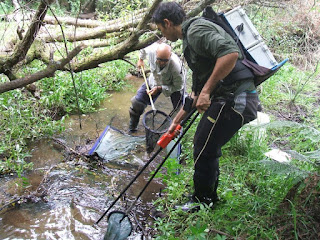Restoration by the community for the community. If you are interested in receiving an email notification every time the blog is updated then register your email on gullyrestoration@gmail.com. Co ordinators are Rex Bushell 854-0973 and Rod Lugton 855-9966 .
Thursday, February 18, 2016
A disappointing year for possum control
The third fresh water fish survey
 Waikato Regional Council fresh water scientist completed a third fish survey of 50 metres of the Mangaiti stream within our restoration area. They are pleased with the consistent results. The highlight of this survey was the recording of a good sized Giant Kokopu and a good sized Long Finned Eel. The Long Finned Eel is the larger of the two eel species found in New Zealand. The Short Finned Eel is the one that is commonly seen and is smaller. The Long Finned Eel is the one that leaves the New Zealand fresh water system when it is ready to breed and migrates up to the Pacific waters to spawn. The glass eels as they are known, presumably because of their transparent look, somehow find their way back to New Zealand and enter fresh water river and stream systems. These are getting endangered and should not be fished.
Waikato Regional Council fresh water scientist completed a third fish survey of 50 metres of the Mangaiti stream within our restoration area. They are pleased with the consistent results. The highlight of this survey was the recording of a good sized Giant Kokopu and a good sized Long Finned Eel. The Long Finned Eel is the larger of the two eel species found in New Zealand. The Short Finned Eel is the one that is commonly seen and is smaller. The Long Finned Eel is the one that leaves the New Zealand fresh water system when it is ready to breed and migrates up to the Pacific waters to spawn. The glass eels as they are known, presumably because of their transparent look, somehow find their way back to New Zealand and enter fresh water river and stream systems. These are getting endangered and should not be fished.
Last major clearing job
Preparing for autumn planting
A road named after us!
Subscribe to:
Posts (Atom)